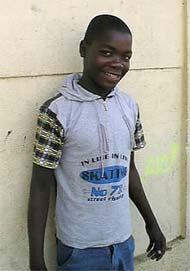Os Vulneráveis: Les Misérables of Angola
The ravages of war coupled with the lack of opportunity for educational and economic advancement have rendered millions of Angolans vulnerable to illiteracy, violence, malnutrition, and disease in the post-war period. Women, children and internally displaced persons are particularly threatened, a condition further exacerbated by impoverishment.
Angola ratified the United Nations' Convention on the Elimination of All Forms of Discrimination Against Women, which states that "a change in the traditional role of men as well as the role of women in society and in the family is needed to achieve full equality between men and women." By official statistics, Angola's parliament boasts 15.5 percent female representation as opposed to the 13.8 percent of seats held by women in the U.S. Congress. However, that statistic can be misleading. Angolan women have told me a different story – the story of a country where war has left only one man for every three women. The dearth of men forces many women to accept either an unfaithful, abusive husband or the social stigmas and vulnerabilities conferred upon single women.
Statistics reveal gender disparities in access to health and education. (All statistics in this dispatch are derived from the latest United Nations Development Program Human Development Report and UN OCHA materials on Angola.)
Almost half of Angolan women (46 percent) are illiterate in contrast to only 18 percent of men. In rural areas, the percentage of illiterate women climbs to 66 percent compared with 40 percent of men. These statistics reveal the effects of discriminatory customs giving preference to educating boys before girls.
Angola's maternal mortality rate of 1,850 deaths per 100,000 live births is among the highest in the world. Furthermore, a study of prenatal patients in Luanda between 1999 and 2001 revealed a 250 percent increase in sero-prevalence of HIV, indicating that AIDS education programs have failed to reach urban women.
The poorest women of Angola are even more vulnerable: they are 650 percent less likely to use contraception and 530 percent less likely to know how HIV/AIDS can be transmitted or prevented. In Angola, as in many other countries across the globe, the gap between rich and poor is widening. A Household Income and Expenditure Survey conducted from 2000-2001 revealed that the richest 10 percent of households increased their share of total household income between 1995 and 2000/2001, from 31.5 percent to 42.2 percent. All other households, those not in the top 10 percent of wealth, experienced a decrease.
 This young shoeshiner is a displaced boy. He can't afford the cost of a trip back to his native Benguelain to search there for his lost family. |
The poorest of Angolan children also suffer from vulnerability: they are 40 percent more likely to die before the age of five, 150 percent more likely to work, 60 percent more likely to be malnourished and 120 percent less likely to be enrolled in school. Though Angola ratified the global Conventions 138 and 182 abolishing child labor, there are 100,000 children separated from their families and communities on the streets of Luanda. These children endure violence, hazardous work and sexual exploitation.
At least one million children in Angola are not enrolled in the formal school system. Without education, their prospects are bleak. Many Angolans fear that as these street children grow up, the lack of opportunity for educational and economic advancement and the exposure to the brutal streets may be a recipe for the return to violence to Angola.
To those who have known the horrors of the protracted war as ex-combatants or as suffering civilians, the thought is unbearable. By October 2002, 850,000 Angolans who had been internally displaced by the war were homeward bound, confronting the challenge of destroyed infrastructure and braving the threat of landmines and unexploded ordnance littering the countryside. Some provinces, like Kwanza Sul, had received up to 10,000 returnees each day, many with few provisions. The UN declared one-third to one-quarter of the population -- 4.3 million Angolans, including ex-combatants, internally displaced persons and returnees -- vulnerable in 2003.
Angolans are optimistic that peace will dissolve the inequities in this country. They are grateful for the support of the international community and the massive coordinated humanitarian effort involving 11 government ministries and department, 10 UN agencies, 112 international NGOs, 356 national NGOs, and 20 donor missions. But, humanitarian agencies are quick to note that their post-war work will soon conclude. Their absence will painfully reveal that peace alone is not enough to nurture the vulnerable – the country and its government system must reach out to those sleeping at the foot of the dumpster or farming between landmines.
Accounts of inequity, whispers of social justice and murmurs of accountability are on the lips of the vulneráveis … and floating on the wind.
— Kristin



